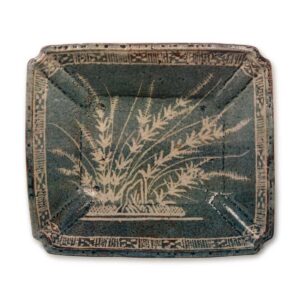
Height 4.7cm, Bore 19.8-22.9cm, Bottom diameter 13.3cm
Suntory Museum of Art
There are quite a few Nezumi-Shino framed plates remaining. This is not a wheel-thrown dish, but rather a tatara dish made by cutting a thin slab of clay and covering it with an earthenware mold. Because it was made in a mold, the form is almost uniform, with a rectangular corner shape with straight open edges and rounded corners. This is one of the most outstanding examples among the many framed dishes in the world, in terms of the elegance of the design and the quality of the glazed surface. The bottom of the dish has legs on all four sides, and the legs are marked, and there are also small marks on the four corners. The design is a bit stiffly carved, but it is well put together. The bottom is brightly burnished and finger marks remain, and the rat color of the glaze is clearly separated from the lighter and darker color in the center, suggesting that the pot was half-submerged. It is believed to have been made by the Omote Kiln in Kusiri. The name “forehead plate” is, of course, a modern term.



